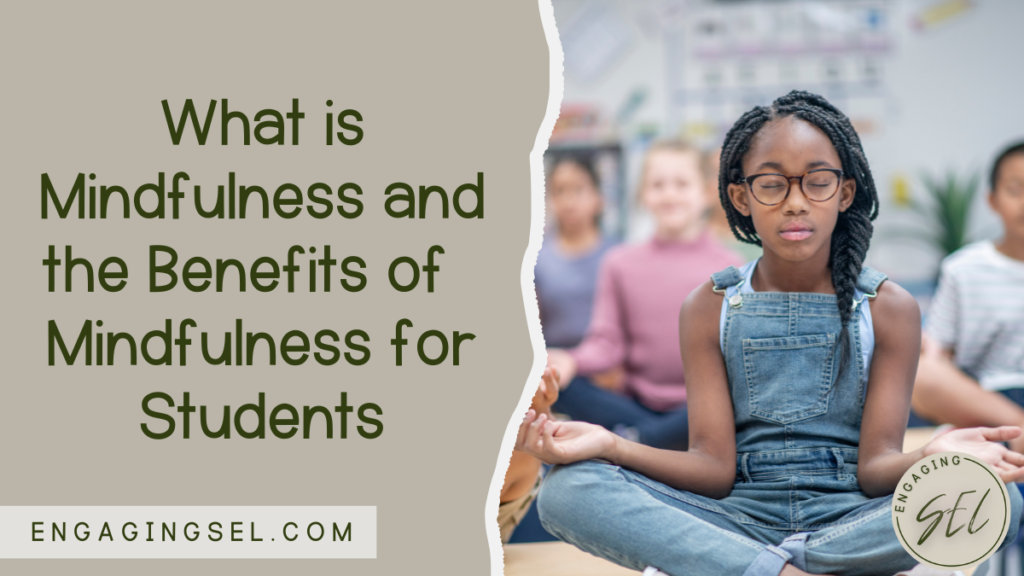
Picture this: You are coming in from recess and all of the students in your class immediately start swarming you with questions and comments before you can even get into the classroom.
“Can I go to the bathroom? What are we doing now? He’s in my space? Can I get a drink of water? My stomach hurts. Is it time to go home yet?”
I’ve been there before. Transitions for kids are tough, especially when students don’t have the tools and resources to cope with them. What if I told you that fixing this problem could be as easy as introducing mindfulness into your daily routine?
What is Mindfulness?
Mindfulness is a type of meditation that focuses on being aware of what a person is sensing or feeling in the moment without judgment. Observing the thoughts, feelings, sensations, and emotions objectively helps achieve a state of alert relaxation. Being able to observe and label the different thoughts, feelings, and sensations objectively helps one be fully present in the moment. Simply put, mindfulness is the practice of paying attention to the present moment and just being aware.
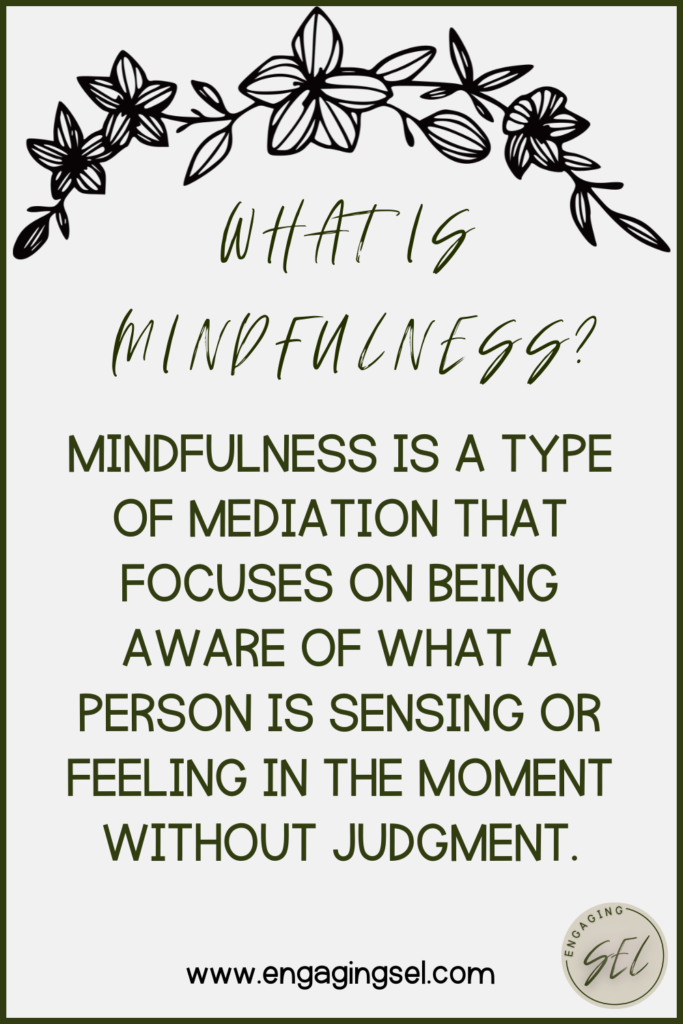
There are many different ways of implementing mindfulness and ways to practice it also. For more on starting mindfulness in the classroom, download my free 7-step guide to starting mindfulness in the classroom.
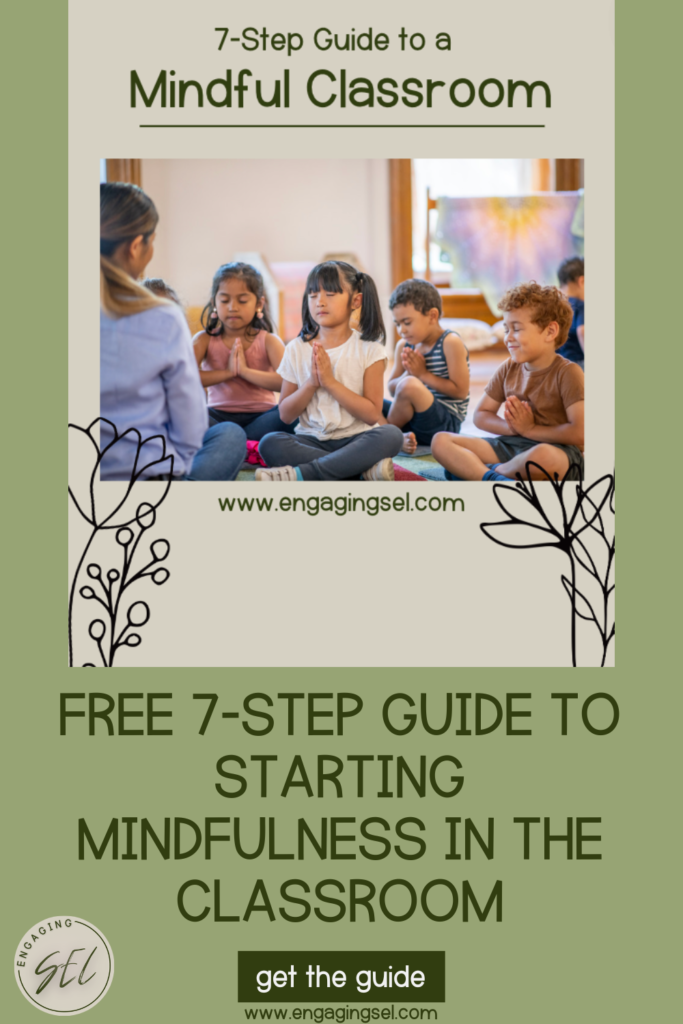
Mindfulness activities can include breathing exercises, visualization, reflection, guided meditation, body scans, or even something as simple as listening to music or counting. There is no one way to start mindfulness with your students and that’s the beauty of it, teacher friend. You can start small with just a few minutes a day and simple activities and work your way up to longer, more advanced practices once your students get the hang of it. You can use it during any part of your day when students might need a breather, need to refocus, or just need a few minutes to get in the zone.
The Transformation from Classroom Chaos to a Calm Classroom
I have seen the transformation from chaos to a calm classroom environment in front of my own eyes when I started using mindfulness in my classroom. My students were coming into the classroom either amped up on a 10 or so low they could fall asleep I could barely get them to open their eyes. It was such a struggle to start teaching in the mornings that I knew I needed something to change. I spent hours researching how to create the calmest classroom environment and in my research, I learned about something called mindfulness. It might be the newest buzzword in education these days but I was intrigued. I had heard of mindfulness before but had no idea how it would help me tame the chaos of my classroom. The more I learned about using mindfulness in the classroom, the more excited I was to try it out and reap the benefits. Implementing a mindfulness routine in my classroom was the best thing I’ve ever done.
It took some adjustments and trial and error before I would say I successfully implemented mindfulness practice in my classroom but once I did, the results spoke for themselves. Let me tell you what I mean….
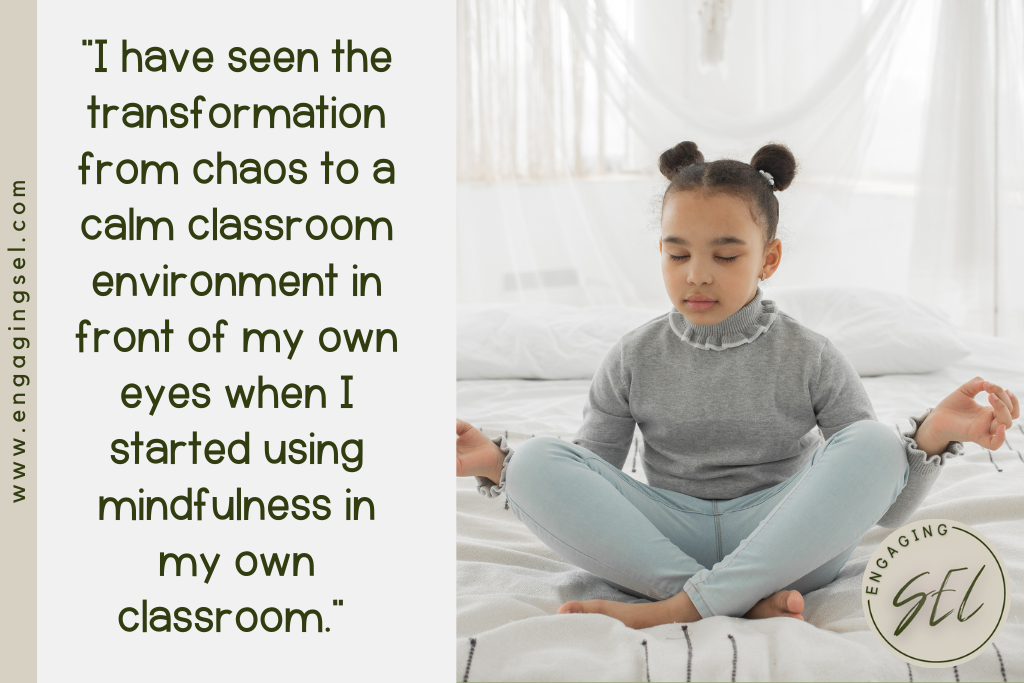
Benefits of Mindfulness in the Classroom
Within a few weeks of starting mindfulness in my classroom and using it a few times every day, I was starting to see a noticeable change in my students. The environment was calmer, the students were more focused and seemed to stay more engaged in my lessons for longer periods. They were also more aware of their bodies and emotions which helped them cope with stress and be more resilient. It was amazing to me that such a small change in our routine could make such a difference. Mindfulness also directly supports the 5 competencies for social emotional learning outlined by The Collaborative for Academic, Social and Emotional Learning (CASEL) which are: Self-Awareness, Self-Management, Social Awareness, Relationship Skills and Responsible Decision-Making.
Improved Focus and Attention
Using mindfulness in the classroom will help students develop better concentration and focus. Being able to focus on the present moment will help students gradually increase their attention spans and ability to focus on one thing at a time. It can also help them limit distractions because they are better able to stay in the present moment and tune out everything else.
After I added mindfulness into our daily routine and used them as brain breaks, I started noticing that students were more focused during lessons and independent work time. They were able to work longer and be engaged for longer periods. It was amazing to see. Students who had struggled to sit on the carpet for more than five minutes could sit through a thirty-minute lesson. Now was it like this all the time for all of my students? No. But it was a drastic improvement overall for the class.
Reduced Stress and Anxiety
Stress is an inevitable part of our lives. Even for young students. Giving them tools to help them manage that stress that comes up is so important. Mindfulness can help students cope with the day-to-day stress and pressure that can come up in the classroom. The amygdala is the fight-or-flight zone in the brain. When students are stressed, this center of the brain is active. Practicing mindfulness regularly leads to less activity in the amygdala. This helps students feel calmer and less reactive throughout the day. The mindfulness practice helps students develop resilience and manage their stress levels throughout the school day.
I have started using mindfulness activities to help my students cope with stressful situations in our classroom. From a few quick deep breaths before a test or a stretch before starting a challenging classroom activity, there are so many ways to use mindfulness to help manage stress. Now my students don’t want to take a test without doing a breathing exercise or a guided meditation. They can’t get enough of it because they love the way it makes them feel and I am here for it! I will tell you, I was beaming when one of my students came up to me and said “ Now my body is calm and I feel ready to do my best” after we finished a yoga session. It was such a good feeling knowing that what I am doing is making a difference in how these kids feel every day.
Emotional Regulation
Mindfulness helps students build emotional intelligence by teaching them to observe their emotions in the present moment without judgment. For more about emotional regulation read Helping Children Regulate Their Emotions. Just noticing what emotions they are feeling in a given moment can help students respond to those emotions in productive, healthy ways. Practicing mindfulness helps students become more self-aware and helps them recognize and regulate their emotions, even when they are not actively practicing mindfulness.
After introducing mindfulness, I noticed that more of my students can identify and label the emotions they are feeling throughout the day. I am better able to support them because we can have a conversation about how they are feeling and what the best way to handle that emotion may be. Students are less reactive and more thoughtful about what is going on with them at the present moment and are better able to use words to express themselves. Overall this has contributed to a calmer classroom environment.
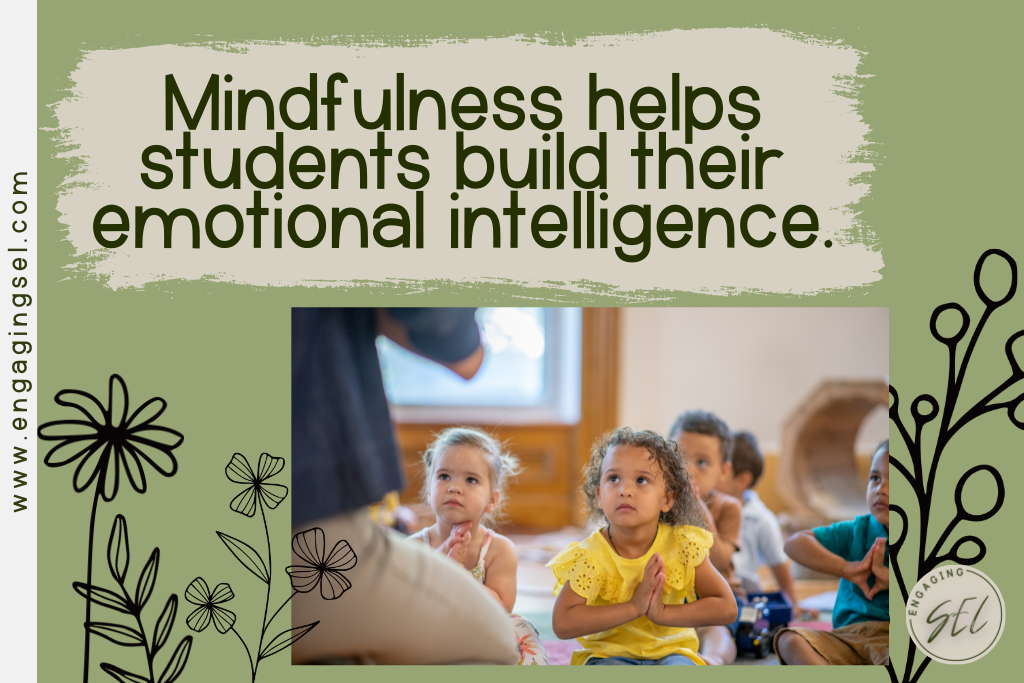
Improved Self-Awareness and Self-Esteem
The observation aspect of mindfulness helps students increase their ability for self-reflection. Many activities in mindfulness are rooted in self-reflection and self-awareness. Taking time to get to know yourself allows students to explore their strengths and areas of growth and develop a positive self-image. This contributes to a growth mindset and a positive classroom environment.
Enhanced Coping Skills
This is the big one for me right here. Coping skills in my classroom were non-existent and it was exhausting. Students were having full-blown meltdowns constantly over all kinds of things. Managing meltdowns and tantrums was the biggest, most tiring part of my day and it seemed never-ending. Coming in from recess was the time I dreaded the most because it seemed like all I did was put out fires that flooded in from the playground. Girl drama fights from the basketball game, someone losing a game of tag, someone didn’t want to play with someone else, someone didn’t get a turn on the monkey bars. It was endless.
Mindfulness supports awareness of emotions, so when students encounter a challenge or a problem, they have the tools to better cope with the situation. Students can take a moment to notice how they are feeling, keep themselves calm and respond to the situation thoughtfully. It can help students manage challenges more effectively, develop problem-solving skills, and help students respond thoroughly and calmly to difficult situations.
Improved Social Skills
Being more aware of themselves and their own emotions supports students in communicating with others more effectively. Mindfulness promotes empathy, active listening, and non-judgemental awareness of others. Just being more in tune with their own emotions and feelings has helped my students become more aware of others and how they are feeling. This has made a huge difference in the overall climate and culture in my classroom. Students can develop respectful and compassionate relationships built on empathy and understanding . Read more about Why Cooperation is Important in the Classroom.
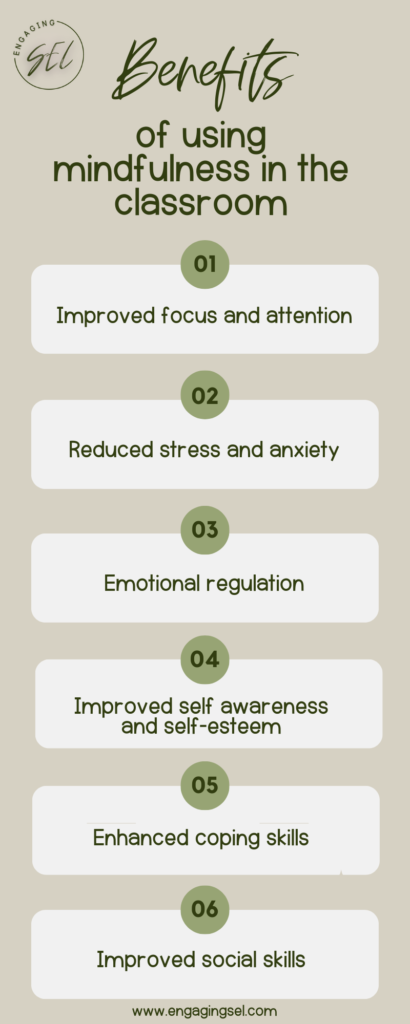
Using Mindfulness in the Classroom
There are so many benefits of using mindfulness in the classroom that it is a no-brainer as to why you should start using it now to transform your classroom climate and culture.
If you need some inspiration to get started, check out my mindfulness activities and resources here. Also, click here to learn more about me and my journey into SEL and mindfulness. I hope this information was helpful to you. I would love to hear how your mindfulness journey is going in your classroom. Connect with me on Instagram, Facebook, and Pinterest, or send me an email at alyssa@engagingsel.com. I can’t wait to hear from you teacher friend.
Best,
Alyssa

